Anyone who has ever tried to take pictures of the night sky knows that it can be a challenge. If your camera settings aren’t optimal, you may end up with a dark photo, motion blur, or unsharp corners. Things get even more difficult if you want a sharp foreground, or if you try to capture deep-sky pictures of distant interstellar objects. Hopefully, this article will give you a good idea of how to set your camera properly for astrophotography.
Before getting too deep into specific recommendations, keep in mind that the techniques in this article are ideal for capturing sharp stars from a landscape photography perspective (where stars aren’t the only thing in your photo). If you’re interested in astrophotography with a telescope, or something like star trails in a landscape photo, you may want to seek more specialized information than the camera settings below.
Focal Length
You can shoot nighttime photos at any focal length, but it depends upon the type of image you want to take.
If your goal is a classic landscape with the Milky Way overhead, and you want everything to be as sharp as possible, the best plan is to use your widest possible lens. Ultra-wide lenses offer a few major advantages for photographing the night sky. First, since they’re so wide, you’ll be able to include more of the Milky Way in your images. Second, because wide lenses have more depth of field, you’ll have an easier time getting the foreground to appear sharp. And third, wide lenses let you use longer exposures before you see any blur from star movement, letting you capture more total light.
Personally, my favorite focal length for this type of photography is anything 20mm and wider, but longer lenses can work, too. And if you don’t mind blurry stars – or you’re intentionally trying to capture that effect – you may prefer a longer focal length instead. For example, I took the image below at 86mm (and used a particularly long exposure) to get motion in the stars:
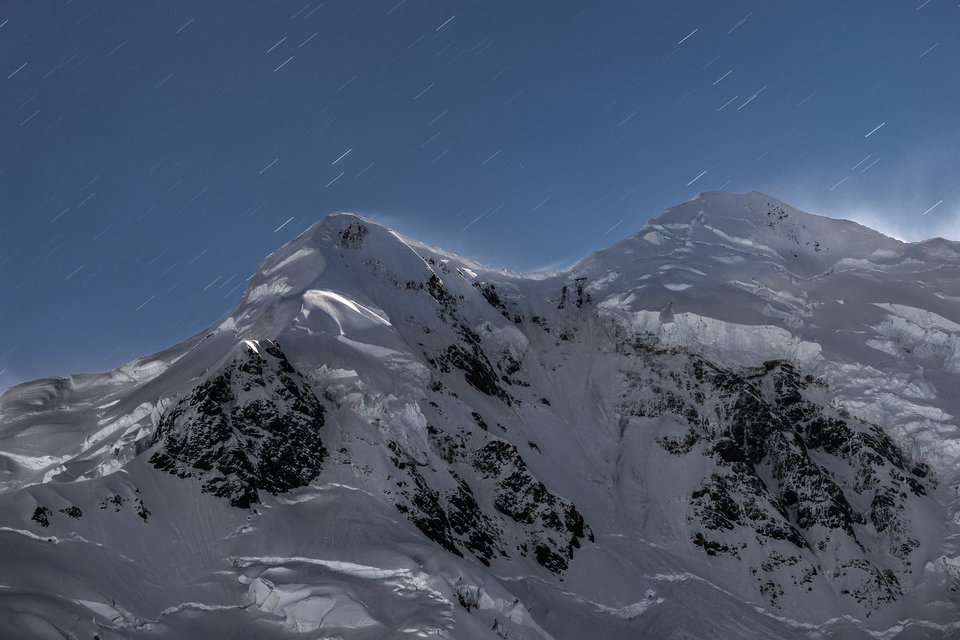
And if you are doing deep-sky astrophotography instead, trying to capture distant objects in the sky, a long lens is obviously the way to go.
Takeaway:
- Use a wide angle lens in order to capture as much of the sky as possible, increase your depth of field, and use longer shutter speeds.
- If you’re trying to capture motion blur in the stars, or you have an equatorial mount (to compensate for Earth’s rotation), use whatever focal length works best for your composition.
Aperture
Normally, aperture is one of the settings you have to worry about the most in photography, at least when it comes to landscapes. With astrophotography, though, it’s a bit easier, since you will almost always want the widest aperture on your lens (or close to it).
The stars are simply so dim that you need to do everything possible in order to capture them as bright as possible. Ideally, your aperture would be f/2.8 or wider, although lenses with a maximum aperture of f/4 can work in a pinch.
Unfortunately, using your lens’s widest aperture comes with a couple issues. Most of all is that your image quality won’t be quite as good, especially in the corners of the photo. And, if you’re including a foreground in your image, the thinner depth of field is not ideal.
So, if your lens’s maximum aperture is something like f/1.4 or f/1.8, you may want to test and see how well it performs at those apertures. Pay close attention to vignetting (dark corners) and coma (smeared stars in the corners). If either of these issues is especially bad, you may want to use an aperture that is about 1/3 stop or 2/3 stop smaller. But if your lens’s maximum aperture is something like f/2.8 or f/4 instead, it usually is not a good idea to stop down any further – 1/3 stop at most – because you’re already pretty short on light.
You’re balancing two goals here: capturing sharper corners versus gathering more light. There is no right answer, and it depends quite a bit upon your lens and personal preferences. If you’re unsure, you might want to take pictures at a few different aperture settings in the field.
Personally, since my main wide-angle lens has a maximum aperture of f/2.8, that’s my typical aperture for astrophotography. But when I shoot Milky Way pictures with my Nikon 20mm f/1.8 lens instead, I’ll use anything from f/1.8 to f/2.2, depending upon the tradeoff I’m willing to make on a given day.
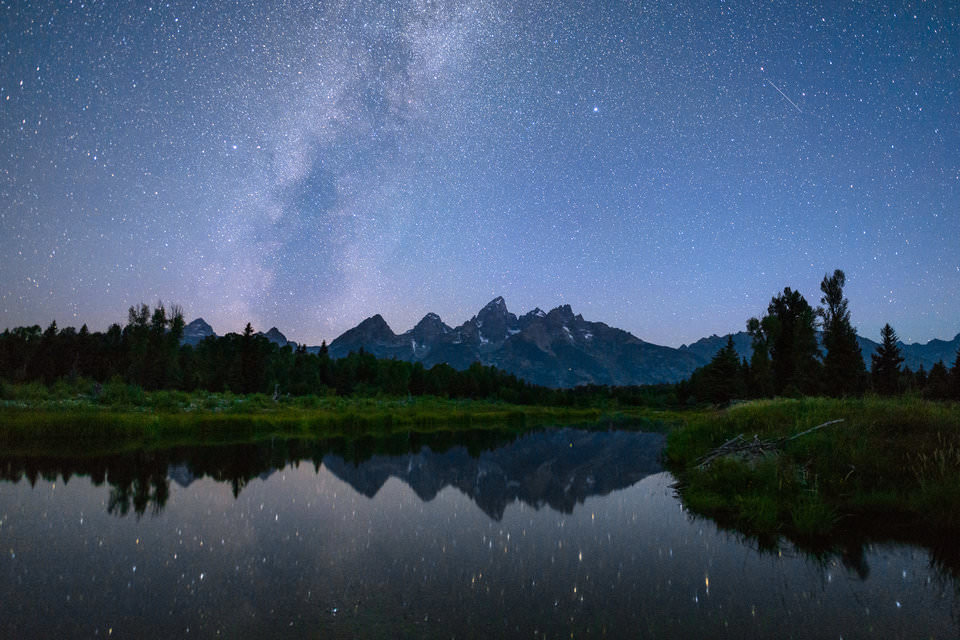
Lastly, if you are doing deep-sky astrophotography, you have more leeway. However, wider apertures are still preferable, since they can cut down your exposure times dramatically. Depending upon the sharpness of your lens and the dimness of your subject, use an aperture around f/2.8 to f/5.6. This one depends very strongly upon your subject, though.
Takeaway:
- Shoot at the widest aperture setting possible, especially if your lens’s maximum aperture is in the range of f/2.8 to f/4.
- If your lens’s maximum aperture is in the range of f/1.4 to f/2, that advice still holds – but make sure you are comfortable with the amount of coma and vignetting in your images. To get slightly sharper corners at the expense of capturing maximum light, use an aperture that is 1/3 to 2/3 stop smaller.
Shutter Speed
The next of the “big three” settings is shutter speed, which is crucial for determining the brightness of your nighttime photo and the amount of motion blur in the stars.
Stars move faster across the sky than you’d think. Although it would be nice to use multi-minute exposures of the Milky Way to capture as much light as possible, you are realistically confined to much shorter shutter speeds if you want sharp stars (and if you’re not using an equatorial mount).
So, how long of a shutter speed can you use before capturing motion blur? It depends upon a number of factors.
First, as mentioned earlier, is your focal length. Wider lenses allow you to use longer shutter speeds before you start to see movement in the stars. A second factor is the direction you’re facing, since stars rotate more slowly around Celestial North and Celestial South (essentially the North Star if you’re in the Northern Hemisphere).
Another factor affecting your shutter speed is your personal willingness to allow motion blur in your photos. I know some photographers who can’t stand any movement at all. Their shutter speeds at night may be no more than five or ten seconds. Other photographers don’t mind star movement as much, and they’re more willing to push the shutter speed in the 20-30 second range for the same shot.
However, there is a point of diminishing returns. Once the star has moved completely away from its original position, a longer shutter speed won’t make it any brighter (aside from the illusion of brightness due to its larger, blurred size). Since many astrophotographers want to capture as many dim stars as possible, it’s important to know that an ultra-long shutter speed is not really the answer (again, assuming you’re not using an equatorial mount). Instead, it might just brighten background light pollution, harming the visibility of the stars.
Ultimately, your shutter speed will be in the range of 10-25 seconds for most nighttime work, with potentially longer or shorter shutter speeds depending upon your situation. Personally, with my 14-24mm f/2.8, I tend to use a shutter speed of 20 or 25 seconds, but it does depend upon the image.
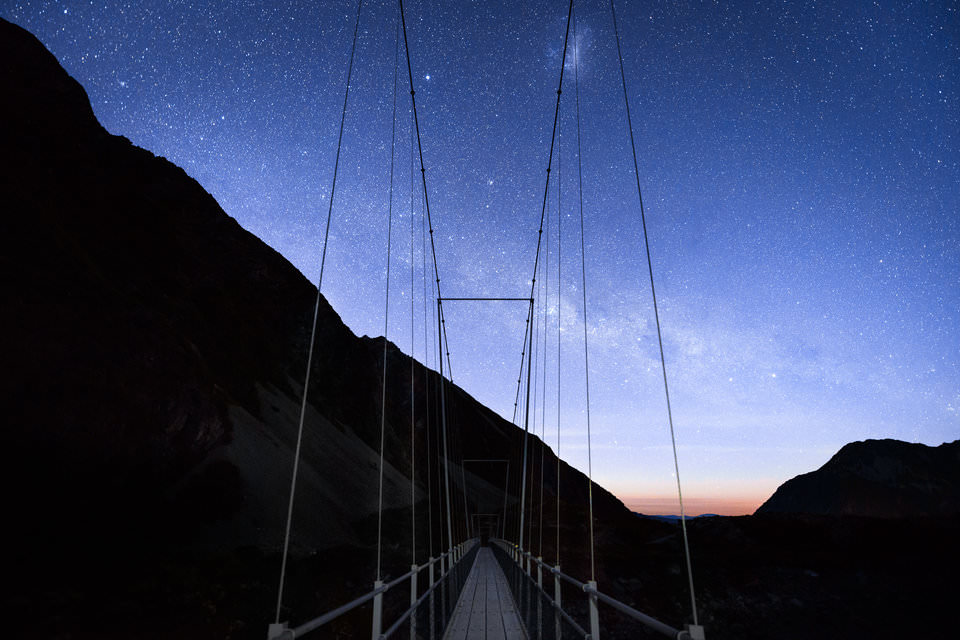
Perhaps the best solution is just to do trial and error in the field. Just take a couple test photos to make sure you’re comfortable with the level of blur in the stars, then move to the creative side of things instead. Although there are some calculations to help you find the optimal shutter speed – some of which are quite accurate, taking the direction you’re photographing into account – it’s often faster just to guess and check. (Though this can get complicated if you’re changing directions frequently or creating a panorama across a wide swath of sky.)
Takeaway:
- Depending upon factors like focal length and composition, you’ll usually be in the range from 10 to 25 seconds if you want all the stars to be sharp.
- You can use in-depth calculators to find the optimal shutter speed, but it’s often quicker just to guess and check.
ISO
It’s often complex to pick the perfect ISO for image quality in photography, and that’s true with the Milky Way as well. There are two schools of thought here:
- Shoot at the ISO that gives you a photo of the right brightness – usually in the range of 1600 to 6400, since it is so dark at night
- Shoot at the ISO that prevents as many stars as possible from “blowing out” – usually in the range of 100 to 400
It’s usually best to do exactly what you would expect and shoot at a high ISO for nighttime photography. However, although it sounds crazy, there are some cases in which you may want to shoot Milky Way photos at base ISO (resulting in a very dark photo) and brightening it in post-production instead.
The following explanation is more technical than many photographers need to worry about. However, I’m including it here because some readers may be interested in knowing how to capture stars with as much color detail as possible.
Specifically, some cameras are close to ISO invariant at low ISOs. This means you see no difference between brightening the photo in-camera with a higher ISO versus brightening in post-processing software like Lightroom or Photoshop. The idea is that higher ISOs in-camera will blow out some detail in the stars, so you might as well shoot at a lower ISO and brighten it later if you have the option. Again, if your camera is ISO invariant, there’s no image quality penalty when you do so. (It’s worth pointing out that most cameras are not ISO invariant to such an extreme degree, but some are close.)
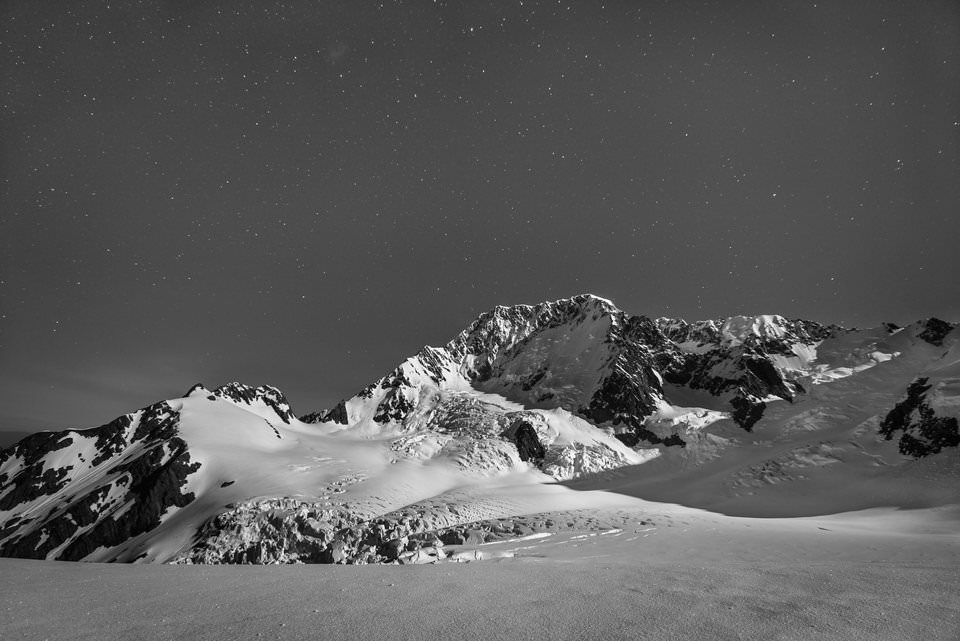
Personally, my Nikon D800e is close to ISO invariant, so this is something I occasionally do. However, it’s not totally invariant at lower ISOs, so I typically don’t bother with this technique. I just shoot at higher ISO values instead, like ISO 1600 (the highest “real” ISO on my camera, as I explained in the ISO invariance article).
That is probably the route you should go as well – just using a high ISO and not worrying about it further – unless you know the nitty-gritty details of your camera sensor and want to gain that extra ounce of detail in your stars.
Takeaway:
- Most photographers should just shoot at whatever ISO value results in bright nighttime photos, typically in the range of ISO 1600 to 6400.
- However, if you know that your camera sensor is ISO invariant through part of its range, it can be preferable to shoot at the lowest ISO that is invariant (the highest “real” ISO) on your camera instead, then brighten the photo in post-production.
Other Settings
Although those are the most important camera settings to keep in mind for astrophotography, they aren’t the only ones that matter. The most major is to shoot RAW rather than JPEG, of course. If you aren’t already doing that – especially for difficult nighttime work – read our RAW vs JPEG article.
It’s worth mentioning that many camera settings don’t affect RAW photos in the same way as JPEGs – they aren’t baked into the file, so your choice won’t impact your ultimate image quality. This is true of things like high ISO noise reduction, white balance, and Picture Control/Style. So, assuming you are shooting RAW, you have far fewer details to worry about in the field.
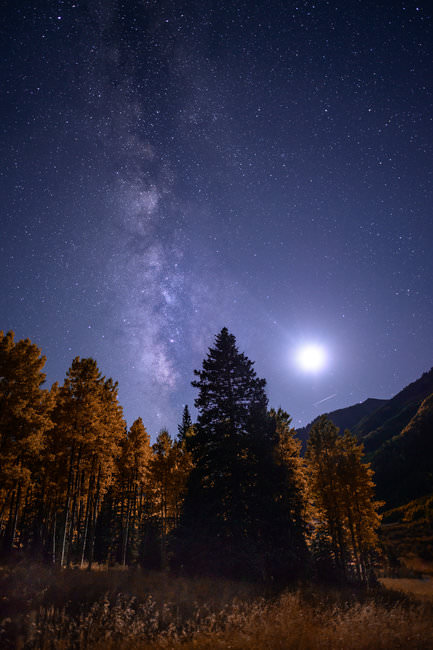
However, some behind-the-scenes settings do still affect RAW images, including one which is practically made for astrophotography: long exposure noise reduction. This option takes two photos in sequence – the first of the scene in front of you, and the second a “dark frame” with nothing in it. This dark frame may appear empty, but it has noise and hot pixels which are similar to those in the first photo. Your camera subtracts the dark frame from the first image, resulting in a cleaner image.
Long exposure noise reduction does impact RAW images, which makes it an important setting to keep in mind. However, because it takes two images in sequence, it also doubles the amount of time spent capturing each image. This might not sound too bad, but it can add up over time to be quite annoying. Instead, some photographers capture dark frames themselves and subtract it in their post-processing software later. Others just leave it turned off. But no matter what you choose, it helps to know that long exposure noise reduction is an option.
And that wraps up the most important camera settings. So long as you’ve focused properly and you’re shooting RAW, all you really need to worry about are aperture, shutter speed, and ISO – not too different from everyday photography. Now, you just need a good composition.
Takeaway:
- Shoot RAW, not JPEG, for maximum image quality.
- Use long exposure noise reduction if you’re willing to wait twice as long per photo in order to reduce noise and hot pixels.
Conclusion
Nighttime photography is a complicated task, and this article only scratches the surface of what you can do. (That should be obvious given the existence of the Hubble Telescope!)
However, my hope is that the recommended settings above give you a good idea of where to start for your own astrophotography. These considerations will change depending upon the shot you want, of course – such as a wide-angle landscape versus a deep-sky image – but everything in the end is about capturing light.
If you have any questions or tips to help fellow photographers capture high-quality star and Milky Way pictures, please feel free to leave a comment below.